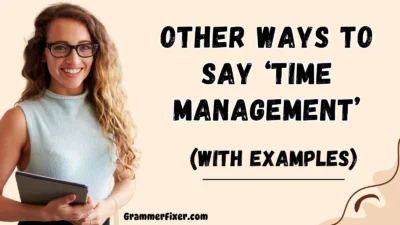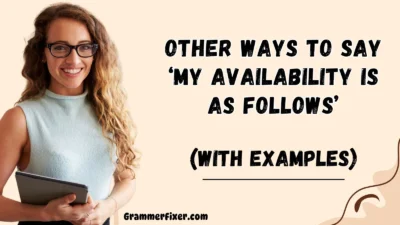Sometimes, finding the right words to give someone a little advance notice can make all the difference in how your message is received. While “Just a Heads Up” is casual and familiar, there are many warm, thoughtful, and professional alternatives that can make your communication feel more personal, caring, and considerate.
Choosing the right phrase not only conveys your message but also reflects your empathy, respect for the recipient’s time, and your intent to keep everyone informed and prepared.
What Does “Just a Heads Up” Mean?
“Just a Heads Up” is an informal expression used to briefly inform someone about something that might be important or relevant to them. It’s often meant as a friendly, preemptive notification so the other person can prepare, adapt, or respond accordingly.
It can be used in both personal and professional communication, though in formal settings, alternatives may be preferred for polish and clarity.
Is It Professional/Polite to Say “Just a Heads Up”?
While “Just a Heads Up” isn’t inherently unprofessional, it can sound too casual in some workplace contexts—especially in written communication like emails to clients, executives, or stakeholders.
In professional settings, you might want to choose more formal, concise, and respectful phrases that still deliver the timely update but with a tone that matches your audience.
Advantages or Disadvantages
Advantages:
- Quick and clear: Conveys urgency without overexplaining.
- Friendly tone: Can make the message feel less formal and more approachable.
- Reduces surprises: Keeps others in the loop and prevents last-minute confusion.
Disadvantages:
- Too informal: May not fit with formal business language.
- Easily misinterpreted: Without context, it can sound like a warning rather than just information.
- Lacks specificity: The phrase doesn’t inherently explain the importance of the update.
1. Please Be Advised
Meaning: A formal phrase used to inform someone of relevant information in a professional context.
Detailed Explanation: This expression communicates that the following information is important and should be noted for awareness or action.
Scenario Examples:
- “Please be advised that the server maintenance will begin at 10 PM tonight.”
- “Please be advised our meeting time has been changed to 2 PM.”
Best Use: Professional emails, official announcements, and policy updates.
Tone: Formal, polite, and authoritative.
2. For Your Awareness
Meaning: Indicates that the message is meant to keep the recipient informed.
Detailed Explanation: This is a neutral, professional way to say you are providing information without expecting immediate action.
Scenario Examples:
- “For your awareness, the marketing team will be conducting a campaign launch next week.”
- “For your awareness, travel policies have been updated.”
Best Use: When you want to loop someone in without demanding a response.
Tone: Informative, neutral, professional.
3. Please Note
Meaning: A short, polite request for the recipient to take notice of the following information.
Detailed Explanation: It works well in business communication to highlight important details while keeping the tone concise.
Scenario Examples:
- “Please note that tomorrow’s meeting will be held in the main conference room.”
- “Please note the deadline for submissions has been extended.”
Best Use: Internal announcements, email reminders, policy notices.
Tone: Polite, concise, professional.
4. Kindly Be Informed
Meaning: A formal way to provide essential information in a respectful tone.
Detailed Explanation: This phrase is common in formal correspondence and signals that the information may require action or consideration.
Scenario Examples:
- “Kindly be informed that the relocation will take place next month.”
- “Kindly be informed that system upgrades will begin on Monday.”
Best Use: Official letters, professional memos, corporate updates.
Tone: Formal, courteous, respectful.
5. In Case You Weren’t Aware
Meaning: A considerate way to inform someone about something they may have missed.
Detailed Explanation: This phrase shows empathy by assuming the person might not have received the information yet, making it softer and more caring.
Scenario Examples:
- “In case you weren’t aware, the quarterly meeting has been moved to Friday.”
- “In case you weren’t aware, our travel policy has recently changed.”
Best Use: Informal internal updates, friendly reminders.
Tone: Gentle, understanding, friendly.
6. A Friendly Reminder
Meaning: A warm and approachable way to bring attention to something important.
Detailed Explanation: Often used to maintain smooth operations without sounding demanding.
Scenario Examples:
- “A friendly reminder that expense reports are due tomorrow.”
- “A friendly reminder to review the attached document at your earliest convenience.”
Best Use: Office notices, team communication, gentle nudges.
Tone: Caring, polite, non-confrontational.
7. I Wanted to Let You Know
Meaning: A personalized, conversational way to share updates.
Detailed Explanation: This phrase makes the message feel direct, thoughtful, and personal.
Scenario Examples:
- “I wanted to let you know that the product launch has been delayed due to supply chain issues.”
- “I wanted to let you know about the changes in the department’s project management software.”
Best Use: Direct emails, one-on-one updates, personalized communication.
Tone: Friendly, engaging, empathetic.
8. For Your Information (FYI)
Meaning: A concise way to pass along informational updates.
Detailed Explanation: Often abbreviated to FYI, it signals that the recipient doesn’t need to act immediately, but should stay informed.
Scenario Examples:
- “FYI, the sales meeting has been rescheduled to accommodate key stakeholders.”
- “FYI, the company’s relocation is set for next month.”
Best Use: Internal communications, non-urgent notifications.
Tone: Neutral, informative, efficient.
9. Just So You Know
Meaning: An informal, conversational way to share relevant details.
Detailed Explanation: This keeps the tone casual, but still helps the other person stay prepared.
Scenario Examples:
- “Just so you know, the town hall will be held at 10:00 AM on Friday.”
- “Just so you know, there might be intermittent disruptions in online services early tomorrow.”
Best Use: Friendly team chats, casual updates.
Tone: Informal, light, friendly.
10. As a Courtesy
Meaning: A polite, formal way to indicate you’re sharing information for their benefit.
Detailed Explanation: Shows respect for the recipient’s time and awareness, often used in business writing.
Scenario Examples:
- “As a courtesy, we are informing you that your proposal deadline has been extended.”
- “As a courtesy, we’ve attached the updated guidelines for your review.”
Best Use: Client communication, professional courtesy emails.
Tone: Respectful, polished, thoughtful.
11. To Keep You in the Loop
Meaning: A friendly way to say you want someone informed and included.
Detailed Explanation: Works well for fostering team collaboration and transparent communication.
Scenario Examples:
- “To keep you in the loop, the renovation will commence Monday, and certain areas will be inaccessible.”
- “To keep you in the loop, our marketing campaign has yielded promising results.”
Best Use: Internal team updates, collaborative projects.
Tone: Inclusive, friendly, open.
12. Here’s a Quick Update
Meaning: Indicates the information will be brief and to the point.
Detailed Explanation: Good for time-sensitive updates without overloading the recipient.
Scenario Examples:
- “Here’s a quick update on yesterday’s client contract with XYZ Corporation.”
- “Here’s a quick update on our project timeline.”
Best Use: Fast-moving projects, urgent communications.
Tone: Efficient, direct, clear.
13. I Thought You Should Know
Meaning: A thoughtful way to share important or potentially impactful information.
Detailed Explanation: This phrase signals care, suggesting you value the recipient’s awareness.
Scenario Examples:
- “I thought you should know that the deadline has been extended.”
- “I thought you should know about the updated security measures.”
Best Use: Sensitive updates, relationship-focused communication.
Tone: Caring, considerate, personal.
14. Before I Forget
Meaning: Casual and slightly urgent, used when you want to make sure the recipient hears something soon.
Detailed Explanation: Works well in spoken or chat-style written communication.
Scenario Examples:
- “Before I forget, the travel policy update is attached here.”
- “Before I forget, the team meeting has been moved to Thursday.”
Best Use: Informal reminders, quick personal updates.
Tone: Casual, light, urgent-but-friendly.
15. A Quick Heads-Up
Meaning: Similar to the original phrase, but slightly warmer and more direct.
Detailed Explanation: Keeps the friendly tone while acknowledging the need for quick notice.
Scenario Examples:
- “A quick heads-up, the IT team will be conducting security upgrades tonight.”
- “A quick heads-up, the sales meeting start time has changed.”
Best Use: Team updates, light professional communication.
Tone: Friendly, clear, informal.
16. Just Flagging This for You
Meaning: A casual yet professional way to highlight something that needs attention.
Detailed Explanation: Common in internal team chats and emails, particularly in project management.
Scenario Examples:
- “Just flagging this for you, the procurement request needs approval by Friday.”
- “Just flagging this for you, the updated document is attached.”
Best Use: Workflow updates, collaboration tools.
Tone: Friendly, collaborative, direct.
17. Worth Mentioning
Meaning: Suggests the detail may not be urgent, but is still relevant.
Detailed Explanation: Adds a touch of humility, implying the information might be useful to know.
Scenario Examples:
- “Worth mentioning, the department’s relocation will begin next month.”
- “Worth mentioning, the proposal deadline has been extended.”
Best Use: Supplemental updates, non-critical information.
Tone: Casual, neutral, friendly.
18. To Give You a Heads-Up
Meaning: A slightly more formal twist on the original phrase.
Detailed Explanation: Retains familiarity but adds a touch more polish and professionalism.
Scenario Examples:
- “To give you a heads-up, the product launch has been delayed.”
- “To give you a heads-up, the IT department will be conducting system tests tonight.”
Best Use: Semi-formal emails, colleague communication.
Tone: Warm, direct, balanced.
19. This Is to Inform You
Meaning: Formal, direct notification language.
Detailed Explanation: Often used in official business correspondence.
Scenario Examples:
- “This is to inform you that your performance review cycle begins next week.”
- “This is to inform you that we are implementing stricter regulatory standards.”
Best Use: Letters, HR notifications, policy changes.
Tone: Formal, clear, official.
20. Bringing to Your Attention
Meaning: Used to highlight something that may require consideration or action.
Detailed Explanation: Sounds professional while showing a degree of courtesy.
Scenario Examples:
- “Bringing to your attention, there’s been a change in the client’s contract terms.”
- “Bringing to your attention, phishing attempts have increased recently.”
Best Use: Important updates, risk communication.
Tone: Professional, serious, courteous.
21. Here’s Something You Should Know
Meaning: Suggests that the information is important and relevant to the recipient.
Detailed Explanation: A conversational yet considerate phrase, it shows you’re thinking about their awareness and preparedness.
Scenario Examples:
- “Here’s something you should know — the town hall meeting will now start at 9:30 AM.”
- “Here’s something you should know — the marketing campaign has exceeded engagement targets.”
Best Use: Informal or semi-formal updates that still carry importance.
Tone: Friendly, caring, inclusive.
22. This Might Be Useful for You
Meaning: Implies that the information may benefit or assist the recipient.
Detailed Explanation: Shows consideration for their needs, framing the update as helpful rather than directive.
Scenario Examples:
- “This might be useful for you — the proposal submission deadline has been extended.”
- “This might be useful for you — here’s the revised travel policy document.”
Best Use: Sharing resources, guidelines, or reference material.
Tone: Helpful, positive, supportive.
23. Just a Quick Note
Meaning: Indicates that the update will be brief and non-intrusive.
Detailed Explanation: Ideal for times when you want to respect the recipient’s time.
Scenario Examples:
- “Just a quick note — the server upgrade will happen tonight.”
- “Just a quick note — the client meeting has been moved to Thursday.”
Best Use: Short internal updates, time-sensitive reminders.
Tone: Concise, friendly, efficient.
24. By the Way
Meaning: A casual phrase for adding information during a conversation or message.
Detailed Explanation: Works best when the update is supplementary rather than critical.
Scenario Examples:
- “By the way, there’s a department lunch on Friday.”
- “By the way, the marketing team’s presentation is rescheduled for next week.”
Best Use: Casual workplace chats, low-priority updates.
Tone: Light, casual, informal.
25. In Advance of
Meaning: Indicates that the information is being given before something happens.
Detailed Explanation: More formal than “heads up,” and emphasizes timely notification.
Scenario Examples:
- “In advance of the product launch, please review the attached campaign materials.”
- “In advance of the meeting, here’s the updated agenda.”
Best Use: Preparing teams or clients for upcoming events.
Tone: Professional, organized, proactive.
26. As a Quick Alert
Meaning: A succinct phrase to signal immediate awareness of something.
Detailed Explanation: Often used in situations where time is critical.
Scenario Examples:
- “As a quick alert, the IT team is currently investigating a server issue.”
- “As a quick alert, there’s been an unexpected change in our delivery schedule.”
Best Use: Crisis communication, urgent updates.
Tone: Serious, timely, clear.
27. So You’re Aware
Meaning: A casual way to keep someone informed without implying urgency.
Detailed Explanation: Neutral tone, implying you value their awareness without asking for action.
Scenario Examples:
- “So you’re aware, the parking lot will be closed on Monday.”
- “So you’re aware, we’ve revised our remote work guidelines.”
Best Use: Informal updates, internal communication.
Tone: Neutral, friendly, informative.
28. Just Bringing This Up
Meaning: Signals that the topic is worth mentioning for the recipient’s benefit.
Detailed Explanation: A softer, conversational approach to introducing new or pending matters.
Scenario Examples:
- “Just bringing this up — the next quarterly sales meeting is rescheduled.”
- “Just bringing this up — the client contract draft is ready for review.”
Best Use: Team updates, meeting reminders.
Tone: Light, collaborative, casual.
29. I Should Mention
Meaning: A conversational way to add important context or updates.
Detailed Explanation: Suggests that the speaker is remembering to share something relevant during the conversation.
Scenario Examples:
- “I should mention, the proposal extension was approved.”
- “I should mention, the retreat itinerary has been finalized.”
Best Use: Mid-conversation inserts, follow-up details.
Tone: Natural, thoughtful, easygoing.
30. For Future Reference
Meaning: Indicates the information will be useful later on.
Detailed Explanation: Positions the update as something that may not require immediate action but should be remembered.
Scenario Examples:
- “For future reference, all expense reimbursement forms must be submitted online.”
- “For future reference, the company’s updated security guidelines are in the shared drive.”
Best Use: Policy notes, process clarifications.
Tone: Informative, forward-looking, professional.
Conclusion
Choosing the right words to replace “Just a Heads Up” can transform your communication style, making it feel more intentional, professional, and empathetic. Whether you’re informing, alerting, or reminding someone, selecting a phrase that matches your tone, context, and relationship with the recipient helps ensure your message is clear, well-received, and impactful.
In professional communication, every word carries weight — so by using these 30 thoughtful alternatives, you can maintain smooth operations, foster productive relationships, and demonstrate respect for the recipient’s time and attention.



